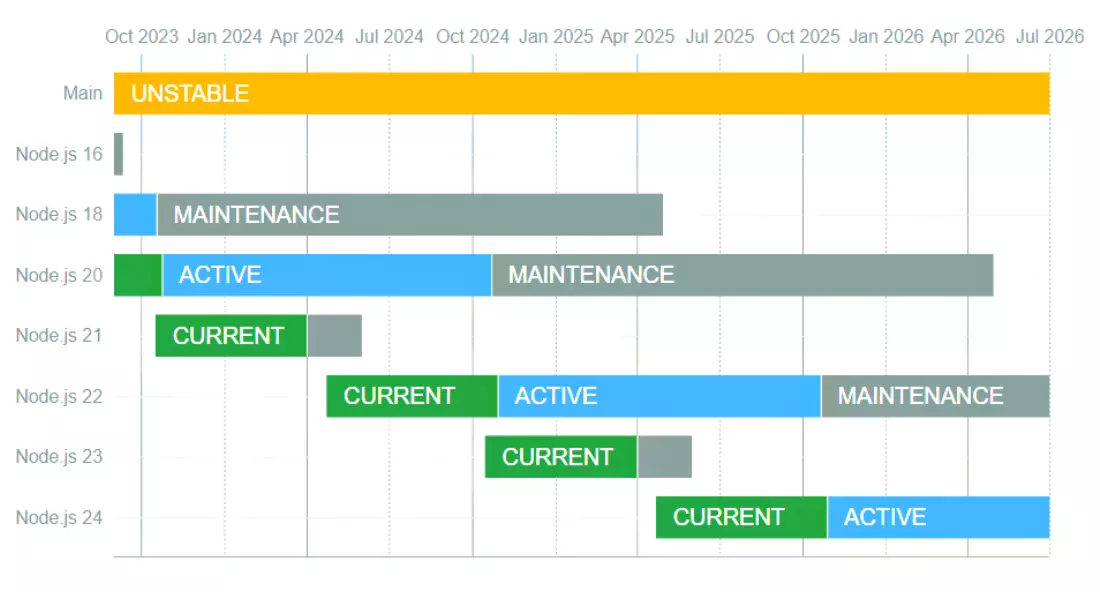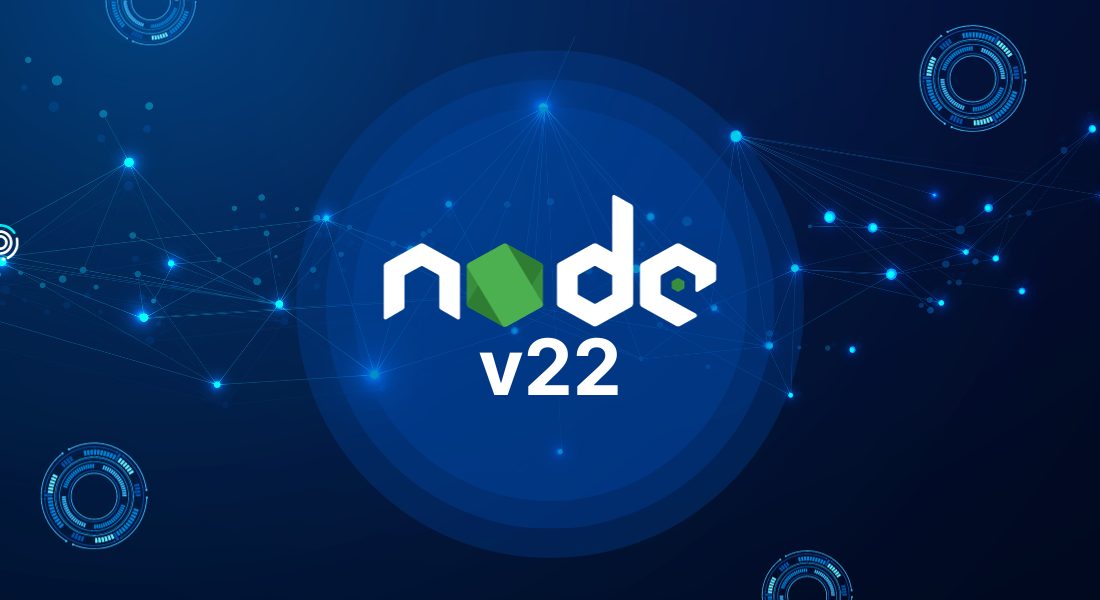Node js 21: Pioneering the Future of Development
Last Updated on April 29, 2024
Quick Summary:
The much-awaited announcement for the Node community and team is over with the release of Node js 21, the latest version of Node js. Its advanced and extensive features have already stolen the spotlight among developers and business owners. Furthermore, this release focuses on boosting performance with optimized runtime execution and decreased memory overhead. On top of that, it has enhanced support for ECMAScript modules and integration with the latest web technologies.
Node js marked another significant moment with its latest Node js version– Node js 21. It has brought advancement and excitement to the Node developers community. Node js releases are semi-annual, with a major version every six months, and LTS releases are supported for at least two years.

However, Node js is not a Long Term Support (LTS) release; it will be supported for at least six months after its release date. It means that it will receive security and bug fixes until April 2024.
The Node.js 21 update brings many new functionality and performance enhancements that promise to revolutionize how we code. In this blog, we will discuss the primary Node js 21 features and enhancements that make this release a must-known for decision-maker.
Node js 20 marked tremendous success with 10 million downloads within the first month of the release, including big companies like Netflix and Uber. Node 21 emerges with refined features and functionality emphasizing performance and bug fixes. Turning our attention to the newest uses of Node js 21, let’s understand it in detail:
The most significant aspect of Node js 21 is the upgradation of the Fetch API to stable. The Fetch API is the modern approach to generating HTTP requests in JavaScript, backed by multiple browsers, and operates in both the backend and frontend.
It has taken over the older XMLHttpRequest API, making the Fetch API more flexible and robust. The highlight of the latest version of Node js 21 is that the Fetch API is now stable, indicating it has been tested and is ready for production thoroughly.
Fetch API provides the following primary advantages in Node js 21:
The WebSocket is a concept introduced previously, as developers have used third-party WebSocket libraries for building real-time applications over the years. However, the WebSocket API is the official implementation of the WebSocket protocol in the Node js framework.
The WebSocket API is the protocol to provide seamless communication between servers and web browsers. It is an ideal protocol for developing applications like multiplayer games, social networking, financial trading, and chat applications.
Note: The WebSocket API is still experimental in Node.js 21 but can be implemented to build real-time applications.
Another significant highlight of Node js is the updated V8 JavaScript Engine – V8 11.8. Michaël Zasso contributed to the new JavaScript engine update, it is an upgraded version, a part of Chromium 118. It helps to enhance performance and includes new language features, such as WebAssembly, Array grouping, and ArrayBuffer.prototype.transfer.
In Node js, V8 11.8 engines are designed to provide faster startup times. V8 11.8 JavaScript engines empower Node js 21 for high performance and maintainability. It helps you to delay the compilation of JavaScript code, and as a result, it boosts Node js performance.
“Updating the V8 engine offers crucial benefits: bug fixes enhance stability, performance improvements boost speed, and new features expand capabilities. It ensures a more reliable, faster, and feature-rich JavaScript runtime environment,” explained Rafael Gonzaga, a Node.js member.
The built-in WebSocket client creates a WebSocket connection within your Node js application. It is easy to implement and found in numerous programming languages, such as JavaScript, Python, and Java. It is mainly employed for developing real-time applications.
In Node js 21, the built-in WebSocket client is optimized for performance, managing many concurrent connections. Also, it is required to create a WebSocket object and define the URL of the WebSocket server you need to connect. For instance, using a built-in WebSocket, you can start receiving and sending messages once the connection is designated.
Hire Nodejs Developers to modernize your application with the latest Node js features and updates.
Another on the list of the essential features in Node js 21 is –experimental-default-type. A new experimental flag enables developers to determine the default type for all imported modules. The –experimental-default-type flag is used in the Package.json file; it could be CommonJs or ESM.
As a result, if you identify Common JS as the default type, all imported modules will be treated as CommonJS modules. It is the traditional default type in Node js. Conversely, suppose you determine ESM as the default type. In that case, all imported modules will be considered ES modules. It is counted as a modern default type in the Node js.
ECMAScript Modules (ESM) is a new module type introduced in Node.js 16. ES modules offer several benefits over CommonJS modules, such as better performance, tree-shaking support, namespaces, and compatibility with multiple modules.
Node js 21 allows you to treat files with a . JS extension by default as a CommonJS module. As a result, it enhances CommonJS compatibility. Also, ES modules are solved and cached based on URL semantics, loaded synchronization, and support dynamic imports.
Another astounding feature of Node js 21 is that it includes several updates to the test runner, allowing you to perform functional testing and export results. As a result, the updates make writing and operating tests easier and allow for meaningful feedback from the outcomes.
In the latest NodeJs version, the test runner supports passing globs to the –test parameter. It means you can use glob expressions to test more flexibly and efficiently. For instance, you can quickly conduct tests for all files with the .test.js extension across numerous guides using a command like node –test **/*.test.js.
The test runner also includes a new CLI flag, –parallelism, which allows you to control the number of tests that are executed in parallel. It can be beneficial for speeding up the test-running process.
NPM 10.2.0 is a modernized release of the popular JavaScript package manager, NPM. In Node js 21, NPM 10.2.0 uses new package resolution algorithms to provide new safety features to support security vulnerabilities.
Furthermore, NPM 10.2.0 includes various performance improvements, such as faster package installation and resolution. It indicates that you can install and manage packages for your Node.js applications more quickly. It also supports the package-lock.json file, which helps to lock down your project’s dependencies and contain unexpected modifications.
Here are the tips for upgrading Node js to latest version seamlessly and efficiently without any bugs:
One of the initial phases of migrating from Node.js 20 to 21 is to update your package.json file. Open your project’s package.json and discover the engines field. Update the version of Node.js to “>=21.0.0” to guarantee compatibility. In addition, you must examine and update devDependencies or any other dependencies that may have distinct version requirements for the latest Node.js 21 version.
For efficient migration, you must review your project’s dependencies to ensure they are compatible with the new Node js 21. For instance, utilize the package manager, such as Yarn or NPM, to upgrade packages to their latest versions. Meanwhile, ensure that there are specific requirements for Node js 21 for dependencies.
Once you have revamped your dependencies, test your application thoroughly on Node.js 21. For instance, look for compatibility problems, deprecated APIs, or behavior changes. Optimizing your code for performance is also a suitable time, to take advantage of any new features in Node.js 21.
After thorough testing and optimization, you must upgrade your codebase as required and move ahead with deployment. Also, ensure to maintain backups and version control this entire process for smoother migration.
Node.js 21 is undoubtedly an excellent choice for business application development. However, the launch of NodeJS 22 has already taken the whole developer community by storm. Let’s glimpse what’s new in NodeJS 22 for your business application development.

In the upcoming Node js 22, support for the latest JavaScript standards like ECMAScript is expected. It will help developers to employ the upgraded JavaScript features in your Node js application. In addition, this will make JavaScript code more readable, concise, and maintainable. For instance, new features will be added in ECMAScript 2023, like class static blocks, export namespace forms, and private class fields.
Another emerging essential feature of Node js 22 would be new built-in modules. This feature will make it easier for developers to develop specific types of Node js applications efficiently. A module like WebAssembly makes your Node js apps scalable and reliable with fewer bug fixes.
It is pretty evident that the Node js 21 update is more than just a version update. It attests to the innovative Node js community and impresses everyone by pushing the environment for better enhancement. With redefined features, improved performance, and more stability, Node js 21 paves the way to make your Node js application more scalable and robust. As a result, the future of JavaScript development is brighter, and the latest version of Node js 21 is taking the leading charge to modernize your Node js applications.
Your Success Is Guaranteed !
We accelerate the release of digital product and guaranteed their success
We Use Slack, Jira & GitHub for Accurate Deployment and Effective Communication.